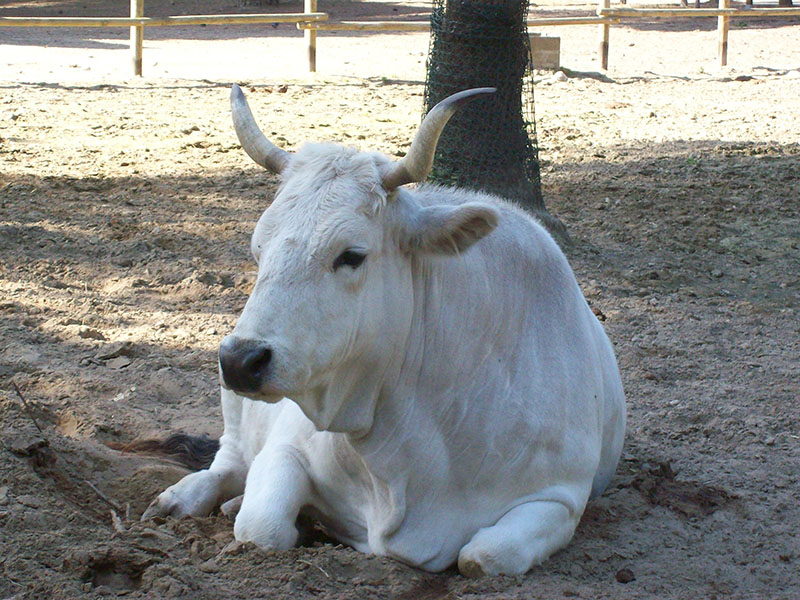Romagnola Cattle
The Romangnola breed of cattle derives from the Bos primigenius podolicus, a wild ox which lived on the Italian peninsula and, to
a great extent also, from the Bos primigenius nomadicus, a bovine originating in the
Euro - Asian steppes, which came to Italy during the fourth century A.D. with the
Gothic invasion led by Aginulf.
Bos primigenius podolicus, a wild ox which lived on the Italian peninsula and, to
a great extent also, from the Bos primigenius nomadicus, a bovine originating in the
Euro - Asian steppes, which came to Italy during the fourth century A.D. with the
Gothic invasion led by Aginulf.
The Romagnola therefore combines the characteristics of both major types of Aurochs, the ancient wild cattle which were the forebears of the modern Bos Taurus and Bos Indicus cattle breeds.
These primitive beasts gave rise to several breeds with similar characteristics throughout Italy. Common traits of these breeds are lyre - shaped horns, black pigmented skin, white or greyish coat and general conformation. In northeastern Italy the amalgamation of Bos primigenius podolicus and Bos primigenius nomadicus saw the formation of a new breed. Since this region, comprising the provinces of Ravenna, Forl and Rimini was known as Romagna, the breed acquired the name Romagnola.
For centuries the main purpose of these animals was to assist man in tilling the fertile plains, with the production of beef as a secondary consideration. The fertile soils and high quality forage contributed significantly to the evolution towards a progressively more muscular type while the continued use of Romagnolas as living tractors ensured their structural soundness and dynamic traits. During the past century the mechanization of agriculture has seen the role of the Romagnola directed specifically into beef production.
The man responsible for the definite change in this direction was Leopoldo Tosi, who developed the first nucleus of selectively bred Romagnola cattle in the mid 1800s in San Mauro Pascoli on the estate of the Counts of Torlonia. This initial herd became the focal point for the entire breed. Over a relatively short period great progress was made such that by the year 1900 the Romagnola was able to win first prize as best beef breed, ex equo, with Herefords at the Paris International Agricultural Fair.
Physiology and Functional Characteristics
Romagnola bulls are among the largest of the beef breeds. Although their very heavy muscling was once sought for draft, that characteristic is now attracting attention to them for meat purposes. Their muscularity over the loin, rump and through the shoulders and lower thigh is especially pronounced. In contrast to the Chianina the Romangnola are much shorter in the leg. The bone structure in this breed is also considered moderate. A study of its proportions, (the rib cage is at least as deep as the distance from the brisket to the ground), places the Romagnola among the meso brachy-morphous breeds.
The breed has a number of distinctive characteristics such as the horns, which are lyre-shaped in cows and half-moon shaped in bulls; the hair which is ivory colored in cows and grey around the eyes and shoulders in the bulls. The skin is black pigmented as also are the extremities, muzzle, horn tips, tail switch, hoofs, vulva, tip of sheath, and base of scrotum. This coloration is an adaptive response to the hot natural climate of the breed. Calves are born a light reddish color and turn white when they are about three months old.
Adult weights on average are 1,250kg (2750 lbs) for bulls and 750kg (1650 lbs) for cows. Sexual maturity is rached relativel early for a large breed. The dispositions are good, and rapid gain, economical feed conversion, good dressing percentages and a good quality carcass are claimed for the breed.
Table 1
Average Weight at 6 Month Interval
| 6 Month | 12 Month | 18 Month | 24 Month | |
|---|---|---|---|---|
| Bulls | 280 kg | 500 kg | 650 kg | 830 kg |
| Cows | 230 kg | 380 kg | 490 kg | 580 kg |
Table 2
Average Height at Withers - 6 Month Intervals
| 6 Month | 12 Month | 18 Month | 24 Month | |
|---|---|---|---|---|
| Bulls | 114 cm | 130 cm | 138 cm | 142 cm |
| Cows | 110 cm | 125 cm | 130 cm | 134 cm |
Registries and Breed Associations
United States
American Romagnola Association
11700 NW Plaza Circle
Kansas City, MO
Phone: (913) 594-1080
References
Briggs, H.M. & D.M. Briggs. Modern Breeds of Livestock. Fourth Edition. Macmillan Publishing Co. 1980
Promotional materials from the American and Italian Romagnola Registries. Cherokee Hills Beefmasters & Romagnola, Carlton & Nancy Laxton, Paris Landing, TN
Phone: (901) 232-8252
